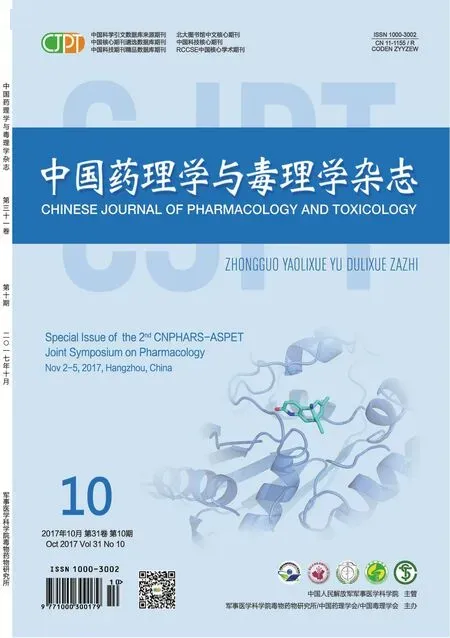Functionally diverse ligands modulate different activation states of the formyl peptide receptor 2,a Gprotein-coupled receptor
Shuo ZHANG,Hao GONG,Richard Dequan YE,2
(1.School of Pharmacy,Shanghai Jiao Tong University,Shanghai 200240,China;2.Institute of Chinese Medical Sciences,University of Macau,Macau SAR 999078,China)
T1-43
Functionally diverse ligands modulate different activation states of the formyl peptide receptor 2,a Gprotein-coupled receptor
Shuo ZHANG1,Hao GONG1,Richard Dequan YE1,2
(1.School of Pharmacy,Shanghai Jiao Tong University,Shanghai 200240,China;2.Institute of Chinese Medical Sciences,University of Macau,Macau SAR 999078,China)
OBJECTIVETo identify the mechanisms by which the formyl peptide receptor 2(FPR2)mediates both inflammatory and anti-inflammatory signaling in an agonist-dependent manner.METHODSCells expressing FPR2 were incubated with weak agonists,Aβ42and Ac2-26,before stimulation with a strong agonist,WKYMVm.Calcium mobilization,cAMP inhibition and MAP kinase activation were measured.Intramolecular FRET were determined using FPR2 constructs with an ECFP attached to the C-terminus and a FlAsH binding motif embedded in the first or third intracellular loop(IL1 or IL3,respectively).RESULTSAβ42did not induce significant Ca2+mobilization,but positively modulated WKYMVm-induced Ca2+mobilization and cAMP reduction in a dose-variable manner within a narrow range of ligand concentrations.Treating FPR2-expressing cells with Ac2-26,a peptide with anti-inflam?matory activity,negatively modulated WKYMVm-induced Ca2+mobilization and cAMP reduction.Intra?molecular FRET assay showed that stimulation of the receptor constructs with Aβ42brought the C-terminal domain closer to IL1 but away from IL3.An opposite conformational change was induced by Ac2-26.The FPR2 conformation induced by Aβ42corresponded to enhanced ERK phosphorylation and attenuated p38 MAPK phosphorylation,whereas Ac2-26 induced FPR2 conformational change corresponding to elevated p38 MAPK phosphorylation and reduced ERK phosphorylation.CONCLUSIONAβ42and Ac2-26 induce different conformational changes in FPR2.These findings provide a structural basis for FPR2 mediation of inflammatory vs anti-inflammatory functions and identify a type of receptor modulation that differs from the classic positive and negative allosteric modulation.
Gprotein-coupled receptors;allosteric modulation;fluorescent resonance energy transfer;formyl peptide receptor 2;conformational changes
The project supported by National Natural Science Foundation of China(31470856 to RDY);the Science and Technology Development Fund of Macau(FDCT 072/2015/A2);and the University of Macau(SRG2015-00047-ICMS-QRCM)
Richard Dequan YE.Tel:15800804313,E-mail:richardye@umac.mo
 中國(guó)藥理學(xué)與毒理學(xué)雜志2017年10期
中國(guó)藥理學(xué)與毒理學(xué)雜志2017年10期
- 中國(guó)藥理學(xué)與毒理學(xué)雜志的其它文章
- Pharmacological study on traditional Chinese medicine and natural product in China
- GPCRomics:tissue and cellular GPCR expression identifies new therapeutic targets
- Direction of new drug research:soft regulation of inflammatory immune responses
- Targeting Gprotein-coupled receptors for the treatment of autoimmune diseases
- Arrestin mediated GPCR biased signaling and its application in new drug discovery
- Identification of a novel target for cancer and anti-fibrotic therapy
